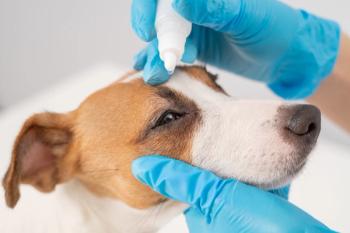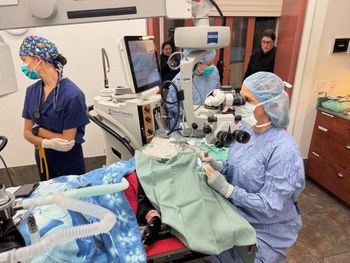
Avian ophthalmology (Proceedings)
Free ranging birds are highly dependent on accurate vision in order to capture prey and forage, to avoid predators, and to find suitable perches and shelter.
Avian ophthalmology
Free ranging birds are highly dependent on accurate vision in order to capture prey and forage, to avoid predators, and to find suitable perches and shelter. Perfect, or near-perfect, ocular health is imperative to survival for most free living avian species. While perfect vision is less vital for the captive companion parrot, it is nevertheless important to recognize and treat ocular disease for the overall health and comfort of the bird. Reported prevalence of ocular disease in birds ranges from 7.6% to up to 26% in birds of prey.
Ocular anatomy
Ocular adnexa
Birds possess two major eyelids. The lower eyelid moves more than the upper eyelid and covers most of the globe when the eye is closed. The eyelids lack Meibomian glands. The third eyelid sweeps components of the tear film produced by the lacrimal gland and Hardarian gland over the eye, and pulls debris and remaining tear film into the puncta of the lacrimal duct. The pyramidalis muscle loops through a sling formed by the quadratus muscle to close the third eyelid, much like the swinging of a pendulum.
Ocular globe
The orbit is open and the ocular globe is comparatively very large in birds. Globe shape varies widely, with parrots having a somewhat flattened globe anterior to posterior. A ring of scleral ossicles helps support the enormous eye in the orbit and to support muscles used in vision accommodation. The iris is composed of striated (voluntary) muscle fibers, an important difference to the iris of mammals, which contains involuntary smooth muscle fibers. The retina is avascular in birds and there is no tapetum. A heavily pigmented portion of the choroid, the pectin, protrudes into the posterior vitreous to provide oxygen and nutrients to the retina. The pectin obscures the optic nerve from visualization. Most birds have a distinct fovea, or increased density of photoreceptors that yield enhanced visual resolution, and some species have two foveolae. Many avian species, particularly diurnal birds, are capable of detecting light in the ultraviolet spectrum (320 to 680 nm). There is complete decussation (cross-over) of the optic chiasm, and therefore birds do not demonstrate a true consensual pupillary light reflex.
Ocular examination
The ocular exam in a bird is similar to that mammals with a few minor differences. The minimum equipment necessary for ocular exam includes a fiber optic Finnoff transilluminator or a bright focused LED penlight, magnification, and a direct ophthalmoscope with a +25D or +40D lens. A slit-lamp biomicroscope is ideal to allow magnification and visualization of the smaller eyes of many species of birds. Indirect ophthalmoscopy using a lens size from 20D to 30D in large birds and up to 90D in smaller birds can allow visualization of a larger area of the fundus at a farther distance from the patient.
Topical parasympatholytic agents such as atropine are ineffective for inducing mydriasis in birds since the iridial muscle fibers are striated. Mydriasis can be achieved with heavy sedation or general anesthesia, or with topical or intercameral neuromuscular blocking agents (NMBA) such as d-tubocurarine. These drugs can have serious adverse effects if improperly used. Topical rocuronium bromide induced consistent mydriasis without noticeable adverse effects in European kestrels (Falco tinnunculus) in one study.
Selected ocular diagnostics
Tear tests
The Schirmer tear test (STT) and the phenol red thread test (PRTT) have been evaluated in avian species. Without topical proparacaine, the reported mean STT value was 7.9 ± 2.6 mm/min (range, 0 to 13 mm/min) in Hispaniolan Amazon parrots (Amazona ventralis) in one study. With proparacaine, the STT value was 5.1 ± 3.3 mm/min (range, 0 to 18 mm/min). The standard STT strip (normally 5 mm x 35 mm) is too wide to fit in the eyes of many avian species. The filter paper can be divided into two smaller sections, but there are no data on tear production values in birds using this modified STT technique.
Alternatively, the PRTT can be used. The PRTT utilizes a 75-mm long cotton thread impregnated with a pH sensitive phenol dye which is inserted into the ventral conjunctival fornix of the eye for 15 seconds. Unlike with the STT, application of proparacaine does not appear to interfere with PRTT results. In 24 Hispaniolan Amazon parrots, the PRTT was 12.5 ± 5.0 mm/min without proparacaine, which compared with 12.6 ± 5.4 mm with the topical anesthetic.
Fluorescein staining
Fluorescein staining is a very useful tool in avian ophthalmology. Topical fluorescein sodium combined with imaging using a cobalt blue light can reveal corneal damage such as ulceration, lacerations, and punctures, as well as obstructive diseases of the lacrimal apparatus.
Intraocular pressure measurement (tonometry)
Reference intervals for intraocular pressure (IOP) using applanation tonometry (eg. Reichert Tono-Pen VetTM Applanation Tonometer, Dan Scott & Associates, Westerville, OH, USA) have been established in a number of avian species including parrots. In one study involving 275 birds with apparently healthy eyes, IOP results using applanation tonometry were between 9.2 and 16.3 mmHg. Reproducible readings have been reported in birds with a corneal diameter of at least 9 mm (the size of an Amazon parrot eye). Readings of eyes with corneal diameters of 5 mm or less (budgerigar range) are not reliable. Newer rebound tonometers (eg. TonoVET Tonometer, Jorgensen Laboratories, Loveland, CO, USA) are able to measure IOP through a cornea as small as 3 mm. Rebound tonometry has been assessed in several avian species such as flamingos and in several raptor species, but data are lacking for psittacine species. Topical anesthesia such as proparacaine is generally applied to the cornea about 10 to 15 seconds prior to IOP measurement.
Radiography, ultrasonography, and advanced imaging
Plain survey radiography can assess for soft tissue periorbital swelling and displaced skull fractures, but has minimal sensitivity for the detection of intraocular diseases other than fracture or displacement of the scleral rings. Evaluation of the ocular structures using standard ultrasonography equipment can be very helpful in visualizing intraocular chambers and structures and for detecting diseases within the surrounding orbit such retrobulbar abscesses or neoplasms. Retinal detachment can even be detected by ultrasonography in larger birds. Imaging through computed tomography (CT) and magnetic resonance imaging (MRI) can provide additional diagnostic information about the ocular globe and surrounding structures.
Cytology and microbiology
Swabs from the conjunctival sac and corneal scrapings can be collected for further evaluation such as cytology, Gram stain, acid fast stain, PCR, and microbiologic culture.
Advanced and emerging diagnostics
Electroretinography is useful in assessing retinal function in birds, but most practices do not possess the necessary equipment for this diagnostic modality. Photopic and scotopic flash electroretinograms (fERGs) were found to be clinically useful in evaluating retinal function in bald eagles (Haliaeetus leucocephalus) in one university study. 3D- and 4D color Doppler ultrasonography allow visualization of pectin blood flow and assess for posttraumatic lesion to the pectin. Ocular coherence tomography (OCT) is a highly sensitive interferometric, image-based technique that measures light reflected from ocular tissue layers. Two and three dimensional sections through the various ocular layers, such as cornea, lens, retina, and choroid, are displayed at almost histologic resolution.
Selected ocular diseases and treatments
Conjunctivitis
Conjunctivitis is common in companion birds. Bacterial agents reported to cause blepharoconjunctivitis in birds include Mycobacterium spp., Chlamydia psittaci, Mycoplasma spp., Escherichia coli, Staphylococcus spp., Streptococcus spp., Pasteurella multocida, Pseudomonas aeruginosa, and Actinobacillus spp. in waterfowl. Almost any organism causing systemic infection can result in conjunctivitis. Viral agents include poxvirus, herpesvirus, goose parvovirus, papovavirus, and adenovirus. The spiruroid nematode parasite Oxyspirura mansoni has been associated with conjunctival irritation, pruritus, and epiphora in cockatoos, mynahs, and other birds. Trematode flukes (Philophthalmus spp.) can cause ocular irritation and have been associated with epiphora in ostriches. Disseminated cryptococcosis (Cryptococcus neoformans) can involve ocular structures. The author has seen fungal dacyrocystitis secondary to topical corticosteroid administration in an Indian ring-necked parakeet (Psittacula krameri manillensis). Foreign bodies are frequently associated with conjunctivitis. Feathers, seed husks, and other debris can become lodged in the conjunctival sac or underneath the third eyelid and can cause significant discomfort and inflammation. The author has seen carpet fibers in a white bellied caique (Pionites leucogaster) migrate from the oral cavity into the lacrimal duct through the choanal cleft and into the eye, causing blepharospasm, epiphora, and conjunctivitis. Treatment is aimed at addressing the underlying cause. Broad-spectrum bactericidal antibiotics can be used, such as bacitracin-polymyxin B, neomycin, gentamicin, tetracycline, and fluoroquinolones such as ofloxacin and moxifloxacin.
Uveitis
Uveitis in birds is most often associated with trauma, infections, immune-mediated diseases, and neoplasia. Blunt or sharp trauma can cause anterior or posterior uveitis and hemorrhage (hyphema). Hypopyon, fibrin clots, and damage to the scleral ossicles can also be seen. Infectious causes of uveitis include encephalomyelitis, Marek's disease, reovirus, and poxvirus. Septicemia caused by any bacterial agent can be associated with uveitis. Clinical signs of anterior uveitis include photophobia, blepharospasm, corneal edema, aqueous flare, miosis, thickening or discoloration of the iris, and anterior or posterior synchiae. With posterior uveitis there may be retinal edema, hemorrhage, or detachment, or vitreous opacity. Treatment is aimed at the underlying cause as well as reduction of inflammation. Topical antibiotics and topical anti-inflammatory agents such as flurbiprofen are often used. Caution is advised for the use of topical corticosteroids such as prednisolone, especially for prolonged treatment periods, as they can be associated with local immunosuppression and secondary infections such fungal keratitis.
Cataracts
Cataracts are common in birds and are associated with advanced age, trauma, and genetics. Hereditary cataracts have been described in Yorkshire and Norwich canaries. Many companion birds blinded by cataracts can maintain a satisfactory quality of life. Lens luxation can be associated with cataracts in birds and is considered a potentially painful condition. Retinal detachment can also occur with mature or hypermature cataracts but is difficult to detect. Lens extraction through irrigation and aspiration or through phacoemulsification in larger birds can be performed and has been described in several avian species.
Glaucoma
Glaucoma is uncommonly diagnosed in birds, likely due in part with the challenges of recording IOP in the smaller avian species. However, glaucoma has been described in avian patients and can be associated with hyphema and uveitis such as lens-induced phacoclastic anterior uveitis. Use of topical and systemic medications for glaucoma have not been evaluated in birds. Because glaucoma is considered a painful condition, enucleation or ocular evisceration should be considered for birds clinically affected and with greatly elevated IOPs.
Ocular neoplasia and xanthoma
A variety of ocular and periocular neoplasms have been reported in birds, including retrobulbar adenocarcinoma, retrobulbar liposarcoma, lymphoma, periorbital cystadenoma, rhabdomyosarcoma, lipoma, and osteosarcoma, among others. Squamous cell carcinoma affecting the infraorbital sinus was associated with exophthalmos in a Solomon Island eclectus parrot (Eclectus roratus solomonensis). While not a true tumor, xanthomas have been described affecting the major eyelids, nictitans, and conjunctiva in psittacine species including Amazon parrots (Amazona spp.) and macaws (Ara spp), among others. Several publications reported successful surgical outcomes.
Suggested reading
Barscotti G, Briganti A, Spratte JR, et al. Safety and efficacy of bilateral topical application of rocuronium bromide for mydriasis in European kestrels (Falco tinnunculus). J Avian Med Surg 2012;26(1):1–5.
Bayón A, Almela RM, Talavera. Avian ophthalmology. Eur J Comp Anim Pract 2007;17(3):253-265.
Carter RT, Murphy CJ, Stuhr CM, et al. Bilateral phacoemulsification and intraocular lens implantation in a great horned owl. J Amer Vet Med Assoc 2007;230(4):559–561.
Carboni DA, Storey ES, Tully TN. Determination of diagnostic ophthalmic test values in normal Hispaniolan Amazon parrots (Amazona ventralis). Proc Assoc Avian Vet 2005:31–34.
Hayat A, Biricik HS. Measurement of tear secretion in healthy pigeons by using the phenol red thread test. Vet Rec Online doi: 10.1136/vr.101379, 2014.
Hoppes S, Gurfield N, Flammer K, et al. Mycotic keratitis in a blue-fronted Amazon parrot (Amazona aestiva). J Avian Med Surg 2000;14(3):185–189.
Jones MP. Fluorophotometric determination of aqueous humor flow rates in red-tailed hawks. Amer J Vet Res 2012;73:551–555.
Jones MP, Pierce KE, Ward D. Avian vision: a review of form and function with special consideration to birds of prey. J Exot Pet Med 2007;16(2):69–87.
Korbel RT. Avian ophthalmology–principles and application. Proc Assoc Avian Vet 2013:227–235.
Kuhn SE, Hendrix DV, Sims MH, et al. Flash electroretinography in the bald eagle (Haliaeetus leucocephalus). J Zoo Wildl Med 2014:45(3);696–699.
Molter CM, Hollingsworth SR, Kass PH, et al. Intraocular pressure in captive American flamingos (Phoenicopterus ruber) as measured by rebound tonometry. J Zoo Wildl Med 2014;45(3):664–667.
Murray M, Pizzirani S, Tseng F. A technique for evisceration as an alternative to enucleation in birds of prey: 19 cases. J Avian Med Surg 2013;27(2):120–127.
Williams DL. Ophthalmology of Exotic Pets. Wiley-Blackwell, West Sussex, UK, 2012.
Willis AM, Wilkie DA. Avian ophthalmology part 1: Anatomy, examination, and diagnostic techniques. J Avian Med Surg 1999;13(3):160–166.
Willis AM, Wilkie DA. Avian ophthalmology part 2: Review of ophthalmic diseases. J Avian Med Surg 1999;13(4):245–251.
Newsletter
From exam room tips to practice management insights, get trusted veterinary news delivered straight to your inbox—subscribe to dvm360.




